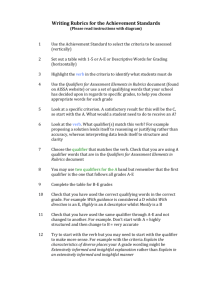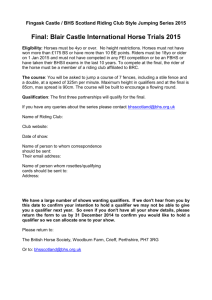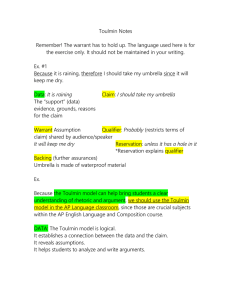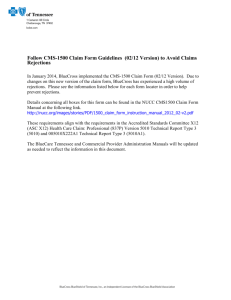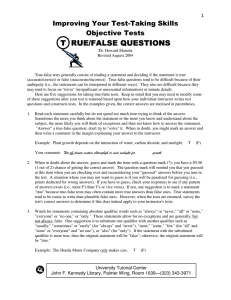Procedures in the ancillary sections
advertisement
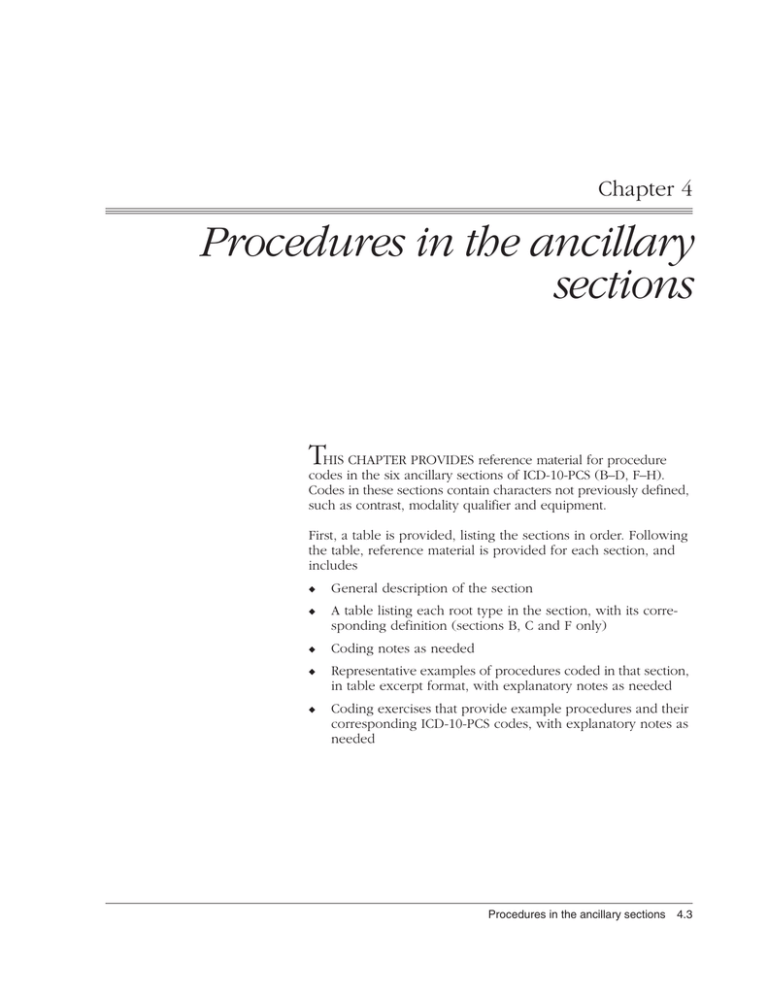
Preliminary 12/10/07 Chapter 4 Procedures in the ancillary sections T HIS CHAPTER PROVIDES reference material for procedure codes in the six ancillary sections of ICD-10-PCS (B–D, F–H). Codes in these sections contain characters not previously defined, such as contrast, modality qualifier and equipment. First, a table is provided, listing the sections in order. Following the table, reference material is provided for each section, and includes ◆ General description of the section ◆ A table listing each root type in the section, with its corresponding definition (sections B, C and F only) ◆ Coding notes as needed ◆ Representative examples of procedures coded in that section, in table excerpt format, with explanatory notes as needed ◆ Coding exercises that provide example procedures and their corresponding ICD-10-PCS codes, with explanatory notes as needed Procedures in the ancillary sections 4.3 12/10/07 Preliminary List of ancillary sections in ICD-10-PCS Six ancillary sections of ICD-10-PCS include procedures such as imaging, radiation oncology, and rehabilitation. 4.4 ICD-10-PCS Reference Manual Section value Description B Imaging C Nuclear Medicine D Radiation Oncology F Physical Rehabilitation and Diagnostic Audiology G Mental Health H Substance Abuse Treatment Preliminary 12/10/07 Imaging—Section B IMAGING follows the same conventions established in the MEDICAL AND SURGICAL section (see chapter 2), for the section, body system, and body part characters. However, the third and fourth characters introduce definitions not used in previous sections. Root types ◆ Third character defines procedure by root type, instead of root operation. ◆ Fifth character defines contrast if used. ◆ Sixth character is a qualifier that specifies an image taken without contrast followed by one with contrast. ◆ Seventh character is a qualifier that is not specified in this section. The IMAGING root types are defined in the following table. Value Description Definition 0 Plain Radiography Planar display of an image developed from the capture of external ionizing radiation on photographic or photoconductive plate 1 Fluoroscopy Single plane or bi-plane real time display of an image developed from the capture of external ionizing radiation on a fluorescent screen. The image may also be stored by either digital or analog means 2 Computerized Tomography (CT scan) Computer reformatted digital display of multiplanar images developed from the capture of multiple exposures of external ionizing radiation 3 Magnetic Resonance Imaging (MRI) Computer reformatted digital display of multiplanar images developed from the capture of radio-frequency signals emitted by nuclei in a body site excited within a magnetic field 4 Ultrasonography Real time display of images of anatomy or flow information developed from the capture of reflected and attenuated high frequency sound waves Procedures in the ancillary sections 4.5 Imaging—Section B 12/10/07 Preliminary Example: X-ray of right clavicle, limited study Character 1 Section Character 2 Body System Character 3 Root Type Character 4 Body Part Character 5 Contrast Character 6 Qualifier Character 7 Qualifier IMAGING NON-AXIAL UPPER BONES PLAIN RADIOGRAPHY CLAVICLE, RIGHT NONE NONE NONE B P 0 4 Z Z Z Example: Fluoroscopy of renal dialysis shunt using CO2 contrast Character 1 Section Character 2 Body System Character 3 Root Type Character 4 Body Part Character 5 Contrast Character 6 Qualifier Character 7 Qualifier IMAGING VEINS FLUOROSCOPY DIALYSIS SHUNT/FISTULA OTHER CONTRAST NONE NONE B 5 1 W Y Z Z Example: CT of brain without contrast followed by high osmolar contrast Character 1 Section IMAGING B Character 2 Body System Character 3 Root Type Character 4 Body Part CENTRAL NERVOUS COMPUTERIZED TOMOGRAPHY BRAIN 0 2 0 Character 5 Contrast HIGH OSMOLAR Character 6 Qualifier Character 7 Qualifier UNENHANCED ENHANCED NONE 0 Z AND 0 Example: MRI of liver using Gadoteridol Character 1 Section Character 2 Body System Character 3 Root Type Character 4 Body Part Character 5 Contrast Character 6 Qualifier Character 7 Qualifier IMAGING HEPATOBILIARY & PANCREAS MAGNETIC RESONANCE IMAGING LIVER OTHER CONTRAST NONE NONE B F 3 5 Y Z Z Example: Ultrasound of prostate gland Character 1 Section IMAGING B Character 2 Body System Character 3 Root Type ULTRA- Character 5 Contrast Character 6 Qualifier Character 7 Qualifier MALE REPRODUCTIVE PROSTATE AND SEMINAL VESICLES NONE NONE NONE SONOGRAPHY V 4 9 Z Z Z Coding exercises 4.6 Character 4 Body Part ICD-10-PCS Reference Manual Using the ICD-10-PCS Tables, construct the code that accurately represents the procedure performed. Preliminary 12/10/07 Imaging—Section B Procedure Code Non-contrast CT of abdomen and pelvis BW21ZZZ Ultrasound guidance for catheter placement, left subclavian artery B342ZZZ Chest X-ray, AP/PA and lateral views BW03ZZZ Endoluminal ultrasound of gallbladder and bile ducts BF43ZZZ MRI of thyroid gland, contrast unspecified BG34YZZ Esophageal videofluoroscopy study with oral barium contrast BD11YZZ Portable X-ray study of right radius/ulna shaft, standard series BP0JZZZ Routine fetal ultrasound, second trimester twin gestation BY4DZZZ CT scan of bilateral lungs, high osmolar contrast with densitometry BB240ZZ Fluoroscopic guidance for percutaneous transluminal angioplasty (PTA) of left common femoral artery, low osmolar contrast B41G1ZZ Procedures in the ancillary sections 4.7 12/10/07 Preliminary Nuclear Medicine—Section C NUCLEAR MEDICINE is organized like the IMAGING section (see page 4.5). The only significant difference is that the fifth character defines the radionuclide instead of the contrast material used in the procedure, as described below. Root types 4.8 ICD-10-PCS Reference Manual ◆ The fifth character specifies the radionuclide, the radiation source used in the procedure. Choices are applicable for the root procedure type. ◆ The sixth and seventh characters are qualifiers, and are not specified in this section. The third character classifies the procedure by root type instead of by root operation. Value Description 1 Planar Nuclear Introduction of radioactive materials into Medicine Imaging the body for single plane display of images developed from the capture of radioactive emissions Definition 2 Introduction of radioactive materials into Tomographic the body for three-dimensional display of (Tomo) Nuclear Medicine Imaging images developed from the capture of radioactive emissions 3 Positron Emission Introduction of radioactive materials into the body for three-dimensional display of Tomography images developed from the simultaneous (PET) capture, 180 degrees apart, of radioactive emissions 4 Introduction of radioactive materials into Nonimaging Nuclear Medicine the body for measurements of organ function, from the detection of radioactive Uptake emissions Preliminary 12/10/07 Nuclear Medicine—Section C Value Description Definition 5 Nonimaging Introduction of radioactive materials into Nuclear Medicine the body for the study of distribution and fate of certain substances by the detection Probe of radioactive emissions from an external source 6 Introduction of radioactive materials into Nonimaging Nuclear medicine the body for the study of body fluids and blood elements, by the detection of Assay radioactive emissions 7 Systemic Nuclear Introduction of unsealed radioactive Medicine Therapy materials into the body for treatment Example: Adenosine sestamibi (technetium) planar scan of heart muscle at rest Character 1 Section Character 2 Body System Character 3 Root Type Character 4 Body Part Character 5 Radionuclide Character 6 Qualifier. Character 7 Qualifier NUCLEAR MEDICINE HEART PLANAR NUCLEAR IMAGING MYOCARDIUM TECHNETIUM 99M NONE NONE C 2 1 G 1 Z Z Example: Technetium tomo scan of liver Character 1 Section NUCLEAR MEDICINE C Character 2 Body System Character 3 Root Type HEPATOBILIARY TOMO NUCLEAR IMAGING AND PANCREAS F 2 Character 4 Body Part Character 5 Radionuclide Character 6 Qualifier. Character 7 Qualifier LIVER TECHNETIUM 99M NONE NONE 5 1 Z Z Procedures in the ancillary sections 4.9 Nuclear Medicine—Section C Coding exercises 12/10/07 Preliminary Using the ICD-10-PCS Tables, construct the code that accurately represents the procedure performed. Procedure Code Tomo scan of right and left heart, unspecified radiopharmaceutical, qualitative gated rest C226YZZ Technetium pentetate assay of kidneys, ureters, and bladder CT631ZZ Uniplanar scan of spine using technetium oxidronate, with first pass study CP151ZZ Thallous chloride tomographic scan of bilateral breasts CH22SZZ PET scan of myocardium using rubidium C23GQZZ Gallium citrate scan of head and neck, single plane imaging CW1BLZZ Xenon gas nonimaging probe of brain C050VZZ Upper GI scan, radiopharmaceutical unspecified, for gastric emptying CD15YZZ Carbon 11 PET scan of brain with quantification C030BZZ Iodinated albumin nuclear medicine assay, blood plasma volume study C763HZZ 4.10 ICD-10-PCS Reference Manual Preliminary 12/10/07 Radiation Oncology—Section D RADIATION ONCOLOGY contains the radiation procedures performed for cancer treatment. Character meanings are described below. Root type ◆ Third character defines root type, which is the basic modality. ◆ Fifth character further specifies treatment modality. ◆ Sixth character defines the radioactive isotope used, if applicable. ◆ Seventh character is a qualifier, and is not specified in this section. The third character defines the treatment modality as root type. Examples are BRACHYTHERAPY and STEREOTACTIC RADIOSURGERY. Four different root types are used in this section, as listed in the table below. Value Description 0 Beam Radiation 1 Brachytherapy 2 Stereotactic Radiosurgery Y Other Radiation Example: LDR Brachytherapy of cervix using Iridium 192 Character 1 Section Character 2 Body System Character 3 Root Type RADIATION ONCOLOGY FEMALE REPRODUCTIVE THERAPY BRACHY- D U 1 Character 4 Body Part CERVIX Character 5 Modal. Qualifier LDR BRACHY- Character 6 Isotope Character 7 Qualifier IRIDIUM 192 NONE 8 Z THERAPY 1 B Example: Intraoperative radiation therapy (IORT) of bladder Character 1 Section Character 2 Body Sys Character 3 Root Type Character 4 Body Part Character 5 Modal. Qualifier Character 6 Isotope Character 7 Qualifier RADIATION ONCOLOGY URINARY SYSTEM OTHER RADIATION BLADDER IORT NONE NONE D T Y 2 C Z Z Procedures in the ancillary sections 4.11 Radiation Oncology—Section D Coding exercises 12/10/07 Preliminary Using the ICD-10-PCS Tables, construct the code that accurately represents the procedure performed. Procedure Code Plaque radiation of left eye, single port D8Y0FZZ 8 MeV photon beam radiation to brain D0011ZZ IORT of colon, 3 ports DDY5CZZ HDR Brachytherapy of prostate using Palladium 103 DV109BZ Electron radiation treatment of right breast, custom device DM013ZZ Hyperthermia oncology treatment of pelvic region DWY68ZZ Contact radiation of tongue D9Y57ZZ Heavy particle radiation treatment of pancreas, four risk sites DF034ZZ LDR brachytherapy to spinal cord using iodine D016B9Z Whole body Phosphorus 32 administration with risk to hematopoetic system DWY5GFZ 4.12 ICD-10-PCS Reference Manual Preliminary 12/10/07 Physical Rehabilitation and Diagnostic Audiology—Section F PHYSICAL REHABILITATION AND DIAGNOSTIC AUDIOLOGY contains character definitions unlike the other sections in ICD-10-PCS. They are described below. Root types ◆ Second character is a section qualifier that specifies whether the procedure is a rehabilitation or diagnostic audiology procedure. ◆ Third character defines the general procedure root type. ◆ Fourth character defines the body system and body region combined, where applicable ◆ Fifth character further specifies the procedure type. ◆ Sixth character specifies the equipment used, if any. This section uses the third character to classify procedures into 14 root types. They are defined in the table below. Value Description Definition 0 Speech Assessment Measurement of speech and related functions 1 Motor and/or Nerve Function Assessment Measurement of motor, nerve, and related functions 2 Activities of Daily Living Assessment Measurement of functional level for activities of daily living 3 Hearing Assessment Measurement of hearing and related functions 4 Hearing Aid Assessment Measurement of the appropriateness and/or effectiveness of a hearing device 5 Vestibular Assessment Measurement of the vestibular system and related functions 6 Speech Treatment Application of techniques to improve, augment, or compensate for speech and related functional impairment 7 Motor Treatment Exercise or activities to increase or facilitate motor function 8 Activities of Daily Living Treatment Exercise or activities to facilitate functional competence for activities of daily living Procedures in the ancillary sections 4.13 Physical Rehabilitation and Diagnostic Audiology—Section F Coding note: Treatment 12/10/07 Preliminary Value Description Definition 9 Hearing Treatment Application of techniques to improve, augment, or compensate for hearing and related functional impairment B Hearing Aid Treatment Application of techniques to improve the communication abilities of individuals with cochlear implant C Vestibular Treatment Application of techniques to improve, augment, or compensate for vestibular and related functional impairment D Device Fitting Fitting of a device designed to facilitate or support achievement of a higher level of function F Caregiver Training Training in activities to support patient’s optimal level of function Treatment procedures include swallowing dysfunction exercises, bathing and showering techniques, wound management, gait training, and a host of activities typically associated with rehabilitation. Example: Wound care treatment of left calf ulcer using pulsatile lavage Character 1 Section Character 2 Section Qualifier REHABILITATION REHABILITATION & DIAGNOSTIC AUDIOLOGY F Character 3 Root Type Character 4 Body System & Region Character 5 Type Character 6 Qualifier Equipment Character 7 Qualifier ACTIVITIES OF DAILY LIVING TREATMENT MUSCULOSKEL. LOWER EXTREMITY WOUND MANAGEMENT PHYSICAL AGENTS NONE 8 L 5 B Z 0 Coding note: Assessment ASSESSMENTS are further classified into more than 100 different tests or methods. The majority of these focus on the faculties of hearing and speech, but others focus on various aspects of body function, and on the patient’s quality of life, such as muscle performance, neuromotor development, and reintegration skills. Example: Articulation and phonology assessment using spectrograph Character 1 Section Character 2 Section Qualifier REHABILITATION REHABILITATION & DIAGNOSTIC AUDIOLOGY F 4.14 Character 3 Root Type Character 4 Body System & Region Character 5 Type Character 6 Qualifier Equipment Character 7 Qualifier SPEECH ASSESSMENT NONE ARTICULATION/ PHONOLOGY SPEECH ANALYSIS NONE 0 Z 9 Q Z 0 ICD-10-PCS Reference Manual Preliminary 12/10/07 Physical Rehabilitation and Diagnostic Audiology—Section F The fifth character used in DEVICE FITTING describes the device being fitted rather than the method used to fit the device. Detailed descriptions of the devices are provided in the reference materials, the table specific to DEVICE FITTING. Coding note: Device Fitting Example: Individual fitting of moveable brace, right knee Character 1 Section Character 2 Section Qualifier Character 3 Root Type Character 4 Body System & Region REHABILITATION REHABILITATION DEVICE FITTING & DIAGNOSTIC AUDIOLOGY F 0 Character 5 Type Character 6 Qualifier Equipment Character 7 Qualifier NONE DYNAMIC ORTHOSIS ORTHOSIS NONE Z 6 E Z D CAREGIVER TRAINING is divided into eighteen different broad subjects taught to help a caregiver provide proper patient care. Coding note: Caregiver Training Example: Caregiver training in feeding, no special equipment used Character 1 Section Character 2 Section Qualifier Character 3 Root Type REHABILITATION REHABILITATION & DIAGNOSTIC AUDIOLOGY F Character 4 Body System & Region Character 5 Type Character 6 Qualifier Equipment Character 7 Qualifier CAREGIVER TRAINING NONE FEEDING AND EATING NONE NONE F Z 2 Z Z 0 Coding exercises Using the ICD-10-PCS Tables, construct the code that accurately represents the procedure performed. Procedure Code Bekesy assessment using audiometer F13Z31Z Individual fitting of left eye prosthesis F0DZ8UZ Physical therapy for range of motion and mobility, patient right hip, no special equipment F07L0ZZ Bedside swallow assessment using assessment kit F00ZHYZ Caregiver training in airway clearance techniques F0FZ8ZZ Application of short arm cast in rehabilitation setting F0DZ7EZ Inhibitory cast is listed in the equipment reference table under E, ORTHOSIS. Procedures in the ancillary sections 4.15 Physical Rehabilitation and Diagnostic Audiology—Section F 12/10/07 Preliminary Procedure Code Verbal assessment of patient’s pain level F02ZFZZ Caregiver training in communication skills using manual communication board F0FZJMZ Manual communication board is listed in the equipment reference table under M, AUGMENTATIVE/ ALTERNATIVE COMMUNICATION. Group musculoskeletal balance training exercises, whole body, no special equipment F07M6ZZ Balance training is included in the MOTOR TREATMENT reference table under THERAPEUTIC EXERCISE. Individual therapy for auditory processing using tape recorder F09Z2KZ Tape recorder is listed in the equipment reference table under AUDIOVISUAL EQUIPMENT. 4.16 ICD-10-PCS Reference Manual Preliminary 12/10/07 Mental Health—Section G MENTAL HEALTH contains specific values in the third and fourth characters to describe mental health procedures. The remaining characters function as placeholders only. Character meanings are described below. Root Type ◆ Third character describes the mental health procedure root type. ◆ Fourth character further specifies the procedure type as needed. ◆ Second, fifth, sixth, and seventh characters do not convey specific information about the procedure. The value Z functions as a placeholder in these characters. The third character describes the mental health root type. There are 11 root type values in this section, as listed in the table below. . Value Description 1 Psychological Tests 2 Crisis Intervention 5 Individual Psychotherapy 6 Counseling 7 Family Psychotherapy B Electroconvulsive Therapy C Biofeedback F Hypnosis G Narcosynthesis H Group Therapy J Light Therapy Example: Galvanic skin response (GSR) biofeedback Character 1 Section Character 2 Body System Character 3 Root Type Character 4 Type Qualifier Character 5 Qualifier Character 6 Qualifier Character 7 Qualifier MENTAL HEALTH NONE BIOFEEDBACK OTHER BIOFEEDBACK NONE NONE NONE G Z C 9 Z Z Z Procedures in the ancillary sections 4.17 Mental Health—Section G Coding exercises 12/10/07 Preliminary Using the ICD-10-PCS Tables, construct the code that accurately represents the procedure performed. Procedure Code Cognitive-behavioral psychotherapy, individual GZ58ZZZ Narcosynthesis GZGZZZZ Light therapy GZJZZZZ ECT (Electroconvulsive therapy), unilateral, multiple seizure GZB1ZZZ Crisis intervention GZ2ZZZZ Neuropsychological testing GZ13ZZZ Hypnosis GZFZZZZ Developmental testing GZ10ZZZ Vocational counseling GZ61ZZZ Family psychotherapy GZ72ZZZ 4.18 ICD-10-PCS Reference Manual Preliminary 12/10/07 Substance Abuse Treatment—Section H SUBSTANCE ABUSE TREATMENT is structured like a smaller version of the MENTAL HEALTH section (see page 4.17). Character meanings are described below. Root Types ◆ Third character describes the root type. ◆ Fourth character is a qualifier that further classifies the root type. ◆ Second, fifth, sixth, and seventh characters do not convey specific information about the procedure. The value Z functions as a placeholder in these characters. There are seven different root type values classified in this section, as listed in the following table. Value Description 2 Detoxification Services 3 Individual Counseling 4 Group Counseling 5 Individual Psychotherapy 6 Family Counseling 8 Medication Management 9 Pharmacotherapy Example: Pharmacotherapy treatment with Antabuse for alcohol addiction Character 1 Section Character 2 Body System SUBSTANCE ABUSE TRMNT. NONE H Z Character 3 Root Type PHARMACO- Character 4 Type Qualifier Character 5 Qualifier Character 6 Qualifier Character 7 Qualifier ANTABUSE NONE NONE NONE 3 Z Z Z THERAPY 9 Procedures in the ancillary sections 4.19 Substance Abuse Treatment—Section H Coding exercises 12/10/07 Using the ICD-10-PCS Tables, construct the code that accurately represents the procedure performed. Procedure Code Naltrexone treatment for drug dependency HZ94ZZZ Substance abuse treatment family counseling HZ63ZZZ Medication monitoring of patient on methadone maintenance HZ81ZZZ Individual interpersonal psychotherapy for drug abuse HZ54ZZZ Patient in for alcohol detoxification treatment HZ2ZZZZ Group motivational counseling HZ47ZZZ Individual 12-step psychotherapy for substance abuse HZ53ZZZ Post-test infectious disease counseling for IV drug abuser HZ3CZZZ Psychodynamic psychotherapy for drug dependent patient HZ5CZZZ Group cognitive-behavioral counseling for substance abuse HZ42ZZZ 4.20 ICD-10-PCS Reference Manual Preliminary

